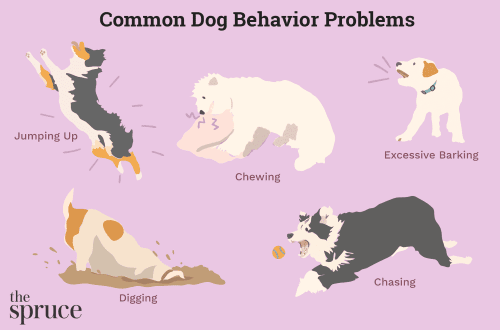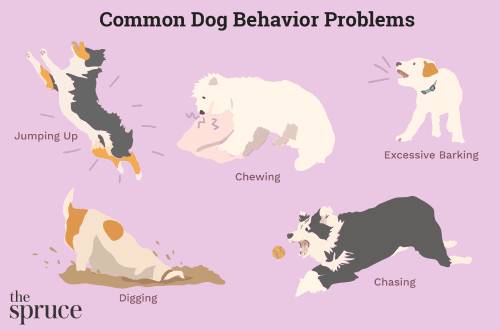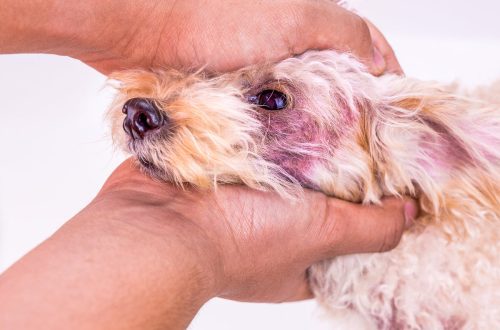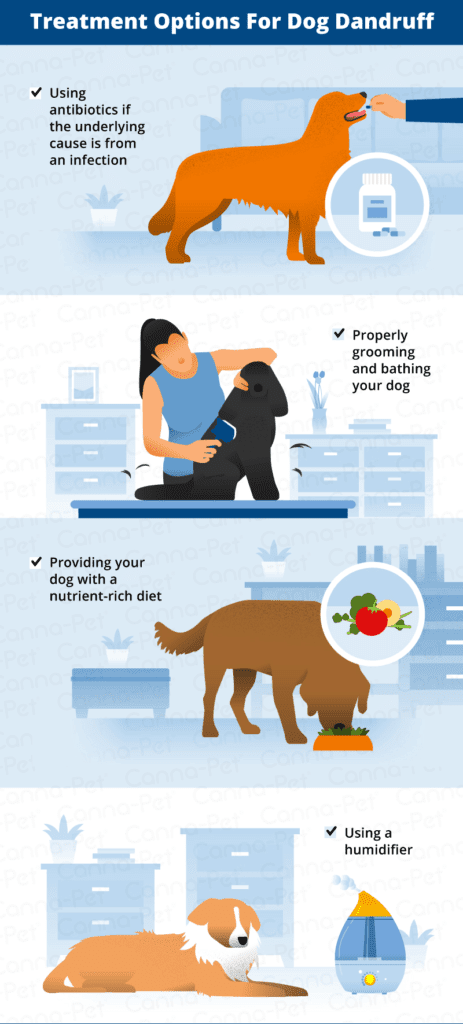
Dandruff in dogs: causes, symptoms, treatment
Contents
What is dandruff and what does it look like?
Dandruff is dead particles of the epidermis. Normally, they are formed in a small amount due to natural aging and death of skin cells. If their formation accelerates, and the number increases significantly (which can be seen with the naked eye), they speak of dandruff.
The particles may resemble flour or flakes; they can be dry or “wet”, stick together into lumps. The location of the scales on the dog’s body is also different: they can cover the body completely, be located in separate places – on the ears, tail, stomach, and so on. In addition, they differ in color shade: not only white, but also black, pinkish, yellow and other particles of the epidermis are often found. In any case, the appearance of dandruff on a pet makes it look untidy and requires an immediate search for the cause.
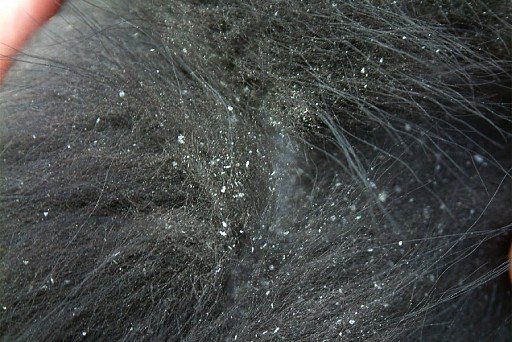
Dandruff in dogs in the photo
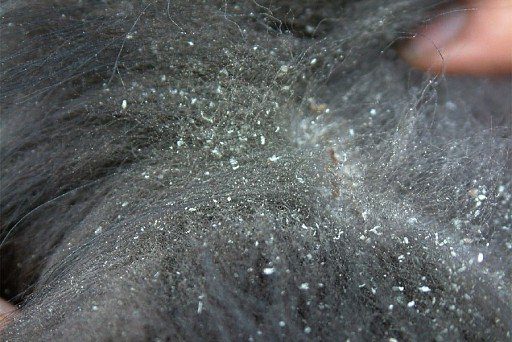
Why does dandruff appear in dogs
There are many causes of dandruff in dogs. Among the most common are the following.
- Dietary disorders. Poor quality food, high content of dyes and preservatives in the pet’s food, the prevalence of one type of food in the diet for a long period of time, food poor in vitamins and minerals, and many other mistakes are the most common factors leading to dandruff.
- Wrong brushing. A brush for a dog should correspond to the characteristics of the coat (length, thickness), sensitivity of the animal’s skin, and body size. Otherwise, damage to the epidermis and a response in the form of abundant exfoliation of scales are possible.
- Parasites. Both external parasites (mites, fleas) and internal ones can lead to the abundant appearance of dandruff. In the latter case, the exfoliation of skin particles is provoked by an allergic reaction to intoxication.
- Dry air. Basically, this applies to dogs living in an apartment, and is associated with heating. Excessively dry air, temperature fluctuations (street – house) lead to the drying of the skin of the animal, which disrupts the processes of cellular renewal.
- care mistakes. This item includes the use of human shampoos to wash the dog, too frequent bathing, the abuse of products intended for exhibition display (for example, varnishes, gels) and other incorrect actions of the owner. As a result, the pet’s skin becomes dry, flaky, and dandruff occurs.
- Molt. The formation of dandruff on the back often accompanies the shedding of the dog. When this period ends, the skin regeneration process is also restored.
- Fungal infections. A fungus can lead to abundant exfoliation of skin scales. More often, fungal diseases affect dogs with a folded body surface.
- Stress. Nervous stress disrupts metabolic processes throughout the dog’s body, including the processes of skin renewal. At the same time, a stressful situation can be provoked by any phenomenon: the departure of the owner, a change of residence, a rearrangement in the house, fear, and so on.
- Age features. In puppies, dandruff may be due to the final development of the epidermis. In puppyhood, the formation of nerve endings and reflexes, the formation of the activity of the sebaceous glands, still continues (and ends).
- Allergy. It can occur on anything: food, substances, hygiene products, other pets, and so on.
- Internal illnesses. Metabolic disorders caused by hormonal failure, malignant tumors, bacterial and viral diseases are often the cause of dandruff in dogs.
Attention: due to the large number of factors leading to the formation of dandruff, diseases and parasites must first be excluded. Before taking independent action, you need to contact the clinic and conduct an examination of the dog.
Dandruff and other symptoms
Dandruff in dogs can occur on its own or may be accompanied by other symptoms that may suggest a cause. For example, a floury appearance of dandruff with a dull coat often indicates dry skin, its insufficient hydration and nutrition.
Sticky particles of the epidermis, a yellowish or gray shade, “hint” at a skin disease, pathology of the sebaceous glands, or hormonal imbalance. Among the additional symptoms: an unpleasant smell, a “dirty”, greasy appearance of the coat, the presence of bald spots, itchy areas. The dog becomes restless, often itches, which leads to the appearance of scratching, the addition of a secondary infection.
Abundant dandruff, accompanied by baldness, is evidence of an infectious skin disease (fungus), a lack of vitamin C and Zn in the body, disorders in the sebaceous glands, and endocrine pathologies. For example, hair loss and excessive detachment of the epidermis at the tail can be a sign of blockage of the anal glands.
Sometimes the wearer may find “dandruff” black in color. In fact, these are droplets of blood or clogged sebaceous glands on the body of a dog, indicating an incorrect pet combing technique or disturbances in the activity of the endocrine and sebaceous glands.
If yellowish dandruff appears, seborrhea can be suspected. The pinkish color of the scales may indicate the development of inflammation of the skin and exfoliation of its pieces.
Methods for diagnosing dandruff in dogs
First of all, the specialist will find out why the dog has dandruff. To do this, the doctor will need the following information:
- accompanying symptoms;
- the presence / absence of chronic or recent acute diseases;
- localization of dandruff and its intensity;
- the general condition of the dog (apathy or activity, thirst, overweight);
- features of nutrition and living conditions of the animal.
The necessary examination will depend on the proposed diagnosis. For example, if a specialist suspects a violation of the thyroid gland, he will prescribe a blood test for hormones, and in the case of skin infections, a scraping of the epidermis.
Treatment for dandruff in dogs
Treatment of dandruff in four-legged friends is symptomatic and is necessarily accompanied by the elimination of the factor that caused it. All manipulations are aimed at alleviating the condition of the dog: eliminating itching, reducing the rate of formation and the number of scales, normalizing metabolic processes in the skin and body, increasing immunity, restoring the pH of the skin, and so on. The key to success is an integrated approach – in addition to treating the underlying disease (if any), prescribe drugs that eliminate the symptoms of dandruff, medicated shampoos, and use folk remedies.
Shampoos
To eliminate itching, clean the dog’s skin from dandruff, veterinarians recommend using shampoos containing salicylic acid, tar, and sulfur. To get rid of parasites, tools are used, which include the appropriate components. The most popular are the following shampoos.
- Lactaderm. It has antiseptic and exfoliating properties. Gently moisturizes the skin and helps restore the upper layer of the epidermis and normal microflora. Has a deodorizing effect.
- Tropicline. Eliminates itching, has a calming effect on irritated skin. Effective in the bites of parasitic insects, leads to their death. Softens the stratum corneum of the epidermis, restores moisture levels in the skin and hairline.
- Doctor. Effectively removes dead skin particles and secretions of the sebaceous glands from the dog’s body. Eliminates itching, reduces the amount of secreted sebaceous secretion, has anti-inflammatory and anti-seborrheic effects. Shampoo Doctor is successfully used for fungal and bacterial infections of the skin, and also increases the effectiveness of other external antimicrobials.
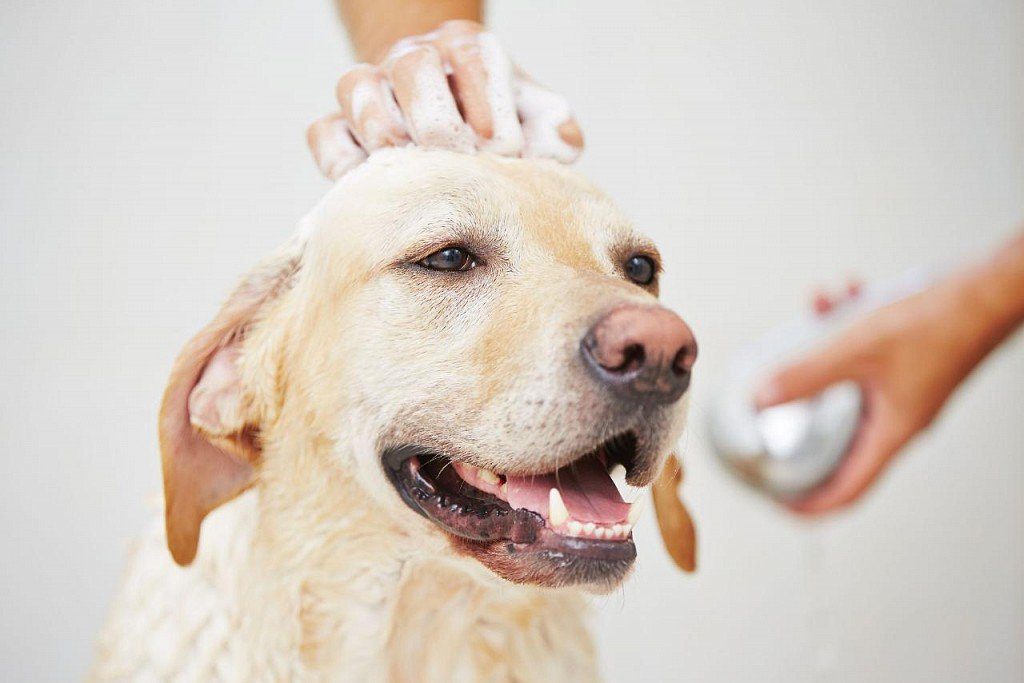
My me completely
Preparations
Simultaneously with shampoos, the use of external and / or internal medicinal preparations is indicated. For example, if the dog is severely itchy, the doctor may prescribe steroid drugs that relieve inflammation. If external parasites are detected, it is possible to use such means as Stronghold (drops), Frontline (spray). To restore hair in dogs, the biological preparation Nucleopeptide is recommended, as well as the French-made Essential. Vitamins Nutricoat and Power balance, Loseval (externally and internally) will help to support immunity, normalize the condition of the skin and coat from the inside.
Additionally, the intake of vitamins A, C, group B is shown. Brewer’s yeast, wheat germ, flaxseed, seaweed and other foods rich in macro- and microelements are added to the feed.
Folk remedies
Alternative methods are also excellent for eliminating the symptoms of dandruff in dogs. Oils, herbal decoctions and infusions are used externally in the form of rubdowns, compresses, lotions; small dogs can be rinsed with decoctions after washing. Chamomile, linden, nettle, burdock relieve inflammation and irritation well. From oils, you can use burdock, sea buckthorn, olives.
How to help a dog with dandruff
No matter what the cause of dandruff in dogs is and what treatment the doctor has prescribed, the owner must take some steps to alleviate the condition of the four-legged friend.
- Make dietary changes. If the food was monotonous – introduce additional products (change food). Enrich the diet with vitamins, especially A and E, omega acids. Ensure an adequate supply of nutrients. Make sure that there are no artificial additives in the food.
- Brush your pet regularly. With a daily procedure, not only exfoliation and removal of dead scales occurs, but also an improvement in blood flow in the epidermis, normalization of metabolism and the functioning of the sebaceous glands.
- Increase the humidity in the house.
- Use only the shampoo approved by your doctor. In no case do not use a hair dryer to dry – the pet should dry naturally.
- If the diagnosis is associated with the presence of external parasites, treat not only the dog, but also the bedding, as well as the apartment (floor, furniture, bedspreads).
Prevention of dandruff in dogs
What can be done to prevent dandruff in dogs? The main preventive measures are as follows:
- ensure the balance of vitamins and minerals, nutrients in the pet’s food;
- eliminate stress;
- do not bathe the dog more than once a quarter (or depending on the pollution);
- use special means for bathing;
- properly comb the dog, use the appropriate comb;
- monitor the condition of the pet’s skin, regularly examine for parasites, skin damage, allergic manifestations.
Dandruff in dogs can be easily cured if it is detected in time and the cause is identified. In advanced cases, treatment can take several months and require significant material costs. In addition, it will be much more difficult to detect a factor provoking a violation, therefore, the key to the health of the animal and the calmness of the owner is an attentive attitude towards the pet.



